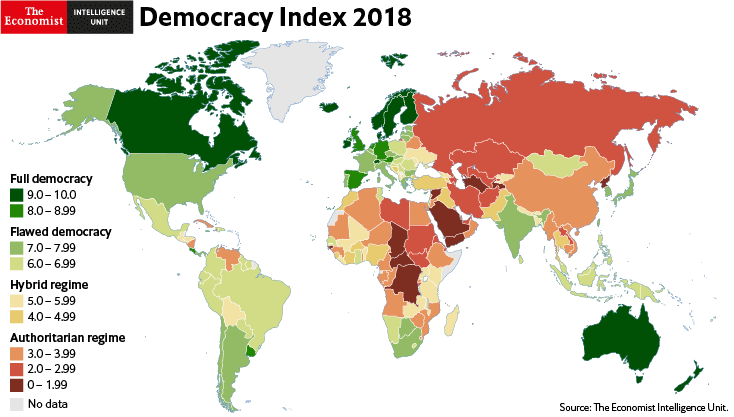Why in news?
The “State of Democracy in the World in 2018” index report titled “Me Too? Political participation, protest and democracy” was published recently.
What is the report on?
- The Democracy Index 2018 measures the state of democracy in 167 countries based on 5 parameters which are:
- electoral process and pluralism
- civil liberties
- functioning of the government
- political participation
- political culture
- It was published by the Economist Intelligence Unit (EIU) which is a global team of economists, industry specialists, policy analysts and consultants.
- It produces data, research and analysis on everything from national elections and international trade, to food security and sustainable cities.
What are the highlights?
- Classification - The index classifies countries into 4 types - Full Democracies, Flawed Democracies, Hybrid Democracies and Authoritarian Regimes.
- Only 20 countries (4.5% of the world population) are full democracies, down from around 11% at the start of this decade.
- Most of the shift has taken place into flawed democracies, which constitute the largest group with 43% of the world’s population.
- A third of the world lives under authoritarian governments, the majority being in China.
- Rankings - The top 5 are Norway (scoring 9.87 out of 10), Iceland, Sweden, New Zealand and Denmark.
- Nordic democracies continue to top the rankings year after year.
- They exhibit high political participation, robust welfare state, progressive workers’ rights and environmental standards.
- The bottom five are generally war-ravaged nations with highly authoritarian regimes.
- These include Chad, Central African Republic, Democratic Republic of Congo, Syria and North Korea.
- North Korea is placed at the bottom, scoring an abysmal 1.08 out of 10.

- SAARC - Among the SAARC countries, India (41) and Sri Lanka (71) are classified as flawed democracies.
- Bangladesh (88), Bhutan (94) and Nepal (97) are categorised as hybrid regimes (mix of democratic and autocratic traits).
- Pakistan (112) and Afghanistan (143) fall under authoritarian regime.
- The Maldives is not being ranked on the index.
- Sri Lanka registered the worst fall among all countries in South Asia.
- It witnesses deteriorating 'civil liberties' and 'functioning of the government' in the wake of the recent constitutional crisis.
- Voters' sentiment - Voter turnout was on the rise in 2018, in expression of dissatisfaction with political parties and "formal political institutions".
- The culture of protest is on the rise, with a number of demonstrations around the world for varied causes.
- The rise of social media has made public outreach quicker and easier, making lawful assembly an increasing trend.
- The report concludes that citizens are “turning anger into action”.
- Participation of women - Positive political discrimination and quotas for women candidates have made parliaments more inclusive.
- Japan introduced women’s quota legislation in 2018.
- In the Indian subcontinent, Nepal tops South Asia in women’s representation, with 33% reservation for women in Parliament and a record 40% of women in local bodies.
- Bangladesh has 14% reserved seats and Pakistan also reserves 17% and 15% in the Lower and Upper Houses respectively.
- [The Indian Parliament should also consider passing the Bill on reservation for women.]
- Individual parameters - 4 out of 5 attributes of the Democracy Index either showed stagnation or improvement for the whole world.
- This is except for “civil liberties” which is on continuous decline since 2008.
- “Functioning of the government” remains at the bottom of the score card, with hardly any improvement from a high of 5.0 since 2008.
- As a whole, the score for perception of democracy as a sub-attribute suffered its biggest fall in the index since 2010.
- This indicates that people are losing faith in the capability of democracy to deliver basic goods and utilities.
What is the case with India?
- India reached it's highest-ever position of 27 in 2014 (just two ranks away from becoming a full democracy).
- Unfortunately, last year, India had slipped to 42, ranking below Latvia and South Africa.
- India has improved one rank this year to 41, but there has been no improvement in scores, which continued at 7.23 out of 10.
- India is now a mid-range country among flawed democracies.
- It has a high score of 9.17 in electoral process and pluralism but moderate record in rest of the parameters with scores not crossing 7.5.
- This confirms the paradox of India as the world’s largest electoral wonder, but a flawed democracy.
What affects India's rankings?
- According to the last two reports, there is a rise of “conservative religious ideologies” in the country.
- Vigilantism, violence, narrowing scope for dissent, threat to minorities and marginalised groups has affected India's ranking.
- Journalists are increasingly under attack, with murders taking place in several areas.
- As a result of limited scope for fair reportage, the Indian media is classified as only “partially free”.
- This is a fact which is also supported by the “Freedom in the World Report, 2018”.
Source: Indian Express
